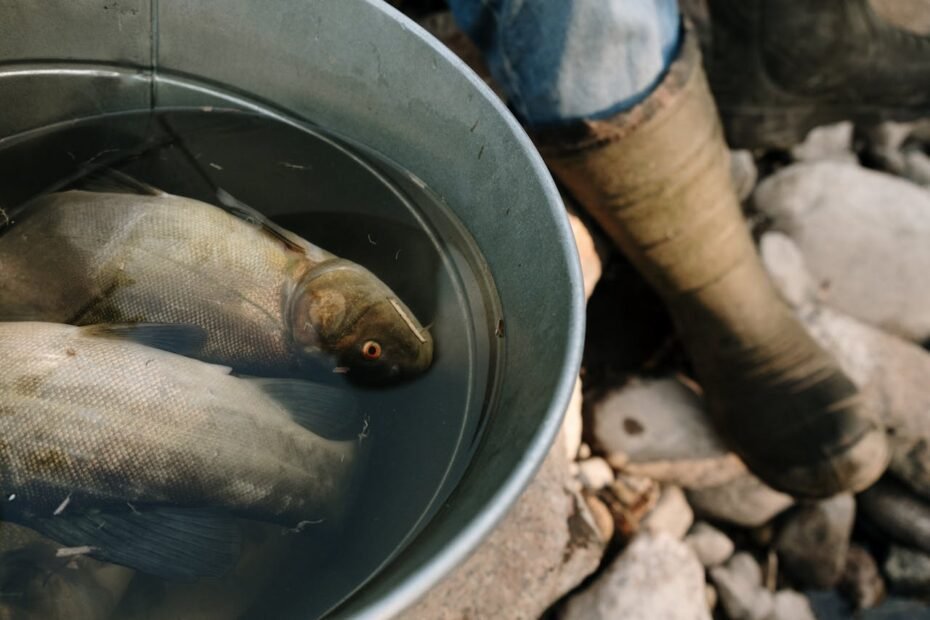Freshwater fish offer a captivating world of color, diversity, and life. Unlike saltwater fish, they thrive in lakes, rivers, and ponds. Their unique biology lets them adapt to low-salt environments, making them special in the aquatic world.
For aquarium enthusiasts, freshwater fish bring vibrant beauty and interactive behavior to home tanks. Anglers, too, find excitement in fishing for game species like bass and trout in freshwater settings. Learning about freshwater fish species, and habitats opens new appreciation and understanding.
Whether keeping them in aquariums or observing them, freshwater fish bring joy and intrigue to all. This guide provides an overview of freshwater fish types, exploring their fascinating biology and how they adapt to diverse ecosystems.
Types of Freshwater Fish
Freshwater fish come in a wide array of species, each with unique characteristics and ecological roles. Some of the most popular categories include:
Tropical Fish: Known for their vibrant colors and adaptability, tropical freshwater fish are popular in home aquariums. Species like the neon tetra, guppy, and angelfish bring beauty and diversity to tanks, making them beginner-friendly choices.
Coldwater Fish: While tropical fish need warmer temperatures, Coldwater species like goldfish and koi thrive in cooler settings. Coldwater fish are hardy, making them a great choice for outdoor ponds or unheated indoor aquariums.
Game Fish: In the wild, game fish such as bass, trout, and catfish attract anglers worldwide. These fish are sought after for both sport and food and managing their populations is vital for sustainable fishing practices.
Bottom Feeders: Bottom-dwelling species like catfish and loaches are essential for maintaining aquarium health, as they help control algae and waste. Bottom feeders are particularly popular for planted or community tanks.
Key Characteristics of Freshwater Fish
Freshwater fish exhibit a range of unique characteristics that distinguish them from marine fish. For example, they possess specialized kidneys that help maintain their internal salt balance in low-salinity environments. Additionally, freshwater fish often display specific behaviors and body shapes suited to their surroundings.
Specifically known as Osmoregulation, this biological trait is essential for the survival of freshwater fish in low-salt environments. Where, they regulate their internal salt and water levels differently than saltwater fish, as they constantly absorb water from their surroundings.
Moving on, many freshwater fish are streamlined, allowing them to navigate currents. In contrast, fish in still waters often have rounded bodies that enhance stability and control. Subsequently, freshwater fish display a range of colors and patterns, often influenced by their habitats. Some, like the brightly colored cichlids, are adapted for clear, shallow waters, while the mottled catfish blend into murkier environments.
Hence, by recognizing these characteristics, fish enthusiasts and hobbyists can create better environments and understand the needs of various species.
Freshwater Fish Habitats and Ecosystems
Freshwater habitats range from fast-moving rivers to serene lakes, each hosting distinct species adapted to their unique conditions. Rivers and Streams are home to fish like trout, bass, and other streamlined species, that adapted to swimming against currents.
Similarly, lakes, particularly larger ones, host diverse fish populations, including larger species like pike and perch. In smaller ponds, you may find goldfish, bluegill, and bass, which adapt well to still waters. Wetlands and Swamps, with shallow, plant-rich waters, support fish that can navigate dense vegetation.
Bowfin and gar are examples of species adapted to such ecosystems. Understanding habitats aids in identifying where certain fish thrive naturally and helps when setting up aquariums that mimic these ecosystems.
Popular Freshwater Fish Species
Selecting a species often depends on experience level, tank size, and water conditions. Proper research ensures a suitable environment, promoting health and longevity. There are thousands of freshwater fish species, but some stand out due to their popularity, beauty, or role in ecosystems:
Betta Fish: Known for their striking colors and flowing fins, bettas are relatively easy to care for. However, they require solitary environments due to their territorial nature.
Guppies: Ideal for beginners, guppies are low-maintenance fish that adapt well to different conditions. They also reproduce quickly, which can be a bonus or a challenge in aquarium management.
Goldfish: Goldfish are hardy, and adaptable, and have been kept as pets for centuries. With various breeds like the fantail, comet, and oranda, they offer options for both tanks and ponds.
Oscar Fish: Large, interactive, and known for their intelligence, Oscars are cichlids that bond with their owners. They require larger tanks and specific water conditions.
Cichlids: Cichlids, including species like angelfish and discus, are loved for their unique personalities. They thrive in well-maintained tanks with stable pH and temperature levels.

Setting Up a Freshwater Aquarium
A well-prepared aquarium enhances the lives of freshwater fish, providing them with a secure and enriching habitat. Here are steps to establish a balanced, beautiful tank:
Choose the Right Tank Size: Freshwater tanks vary in size. Beginners can start with a 10-20 gallon tank, while experienced aquarists opt for larger tanks for bigger or multiple species.
Establish Water Quality: Freshwater fish are sensitive to changes in water quality. Using a reliable filter, monitoring pH, and testing for ammonia, nitrate, and nitrite levels ensures a safe environment.
Add Substrate and Plants: Many fish species benefit from plants and substrates that replicate their natural habitats. Gravel, sand, and live plants can provide hiding spots and encourage natural behaviors.
Cycle the Tank: Tank cycling is essential for establishing beneficial bacteria, which help break down waste. Cycling typically takes 4-6 weeks and should be completed before introducing fish.
Regular Maintenance: Cleaning the tank, changing water regularly, and checking equipment ensure a stable environment. Many aquarists find that maintenance becomes easier with routine.
Caring for Freshwater Fish
Caring for freshwater fish involves attention to feeding, health monitoring, and creating a stress-free environment. Different fish species have specific dietary requirements, from herbivores and carnivores to omnivores. Therefore, providing varied, high-quality foods supports healthy growth and vibrant coloration.
Health monitoring is essential as fish diseases, such as ich or fin rot, can affect even the healthiest tanks. Recognizing signs like erratic swimming, spots, or discoloration early allows for timely treatment. Don’t forget fish experience stress from sudden changes in the environment, poor water quality, or overcrowding.
Ensuring consistent water conditions and a proper tank setup minimizes stress, helping fish thrive. Understanding these basics of fish care fosters healthier, longer lives for freshwater fish, whether kept as pets or enjoyed in the wild.
Conservation and Environmental Impact
Freshwater fish face various threats in the wild due to pollution, habitat destruction, and overfishing. Many species are now endangered, which affects entire ecosystems. Conservation efforts focus on preserving water quality, regulating fishing practices, and protecting natural habitats.
You can also contribute by supporting sustainable fishing, choosing environmentally friendly fish for aquariums, and raising awareness. Learning about conservation helps preserve freshwater fish diversity for future generations.
Conclusion
Freshwater fish represent a fascinating and varied group of creatures that enrich our ecosystems and aquariums. By understanding their habitats, characteristics, and care needs, we can enjoy their beauty responsibly. Whether you’re a beginner starting with guppies or an enthusiast creating a community tank, there is always more to learn.
Through mindful practices and conservation efforts, we can ensure that these aquatic companions continue to thrive. Enjoy the journey of discovering and caring for freshwater fish, and contribute to preserving their beauty for years to come.
